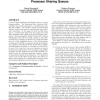48 search results - page 9 / 10 » A Hardware Relaxation Paradigm for Solving NP-Hard Problems |
TON
2010
13 years 4 days ago
2010
Disruption tolerant networks rely on intermittent contacts between mobile nodes to deliver packets using a storecarry-and-forward paradigm. We earlier proposed the use of throwbox ...
ISPD
2004
ACM
13 years 11 months ago
2004
ACM
VLSI placement tools usually work in two steps: First, the cells that have to be placed are roughly spread out over the chip area ignoring disjointness (global placement). Then, i...
ICCD
2007
IEEE
14 years 2 months ago
2007
IEEE
We present new techniques for explicit constraint satisfaction in the incremental placement process. Our algorithm employs a Lagrangian Relaxation (LR) type approach in the analyt...
ISCA
2002
IEEE
13 years 5 months ago
2002
IEEE
In this paper, we consider the tree task graphs which arise from many important programming paradigms such as divide and conquer, branch and bound etc., and the linear task-graphs...
SIGMETRICS
2008
ACM
13 years 5 months ago
2008
ACM
Control of large distributed cloud-based services is a challenging problem. The Distributed Rate Limiting (DRL) paradigm was recently proposed as a mechanism for tackling this pro...

